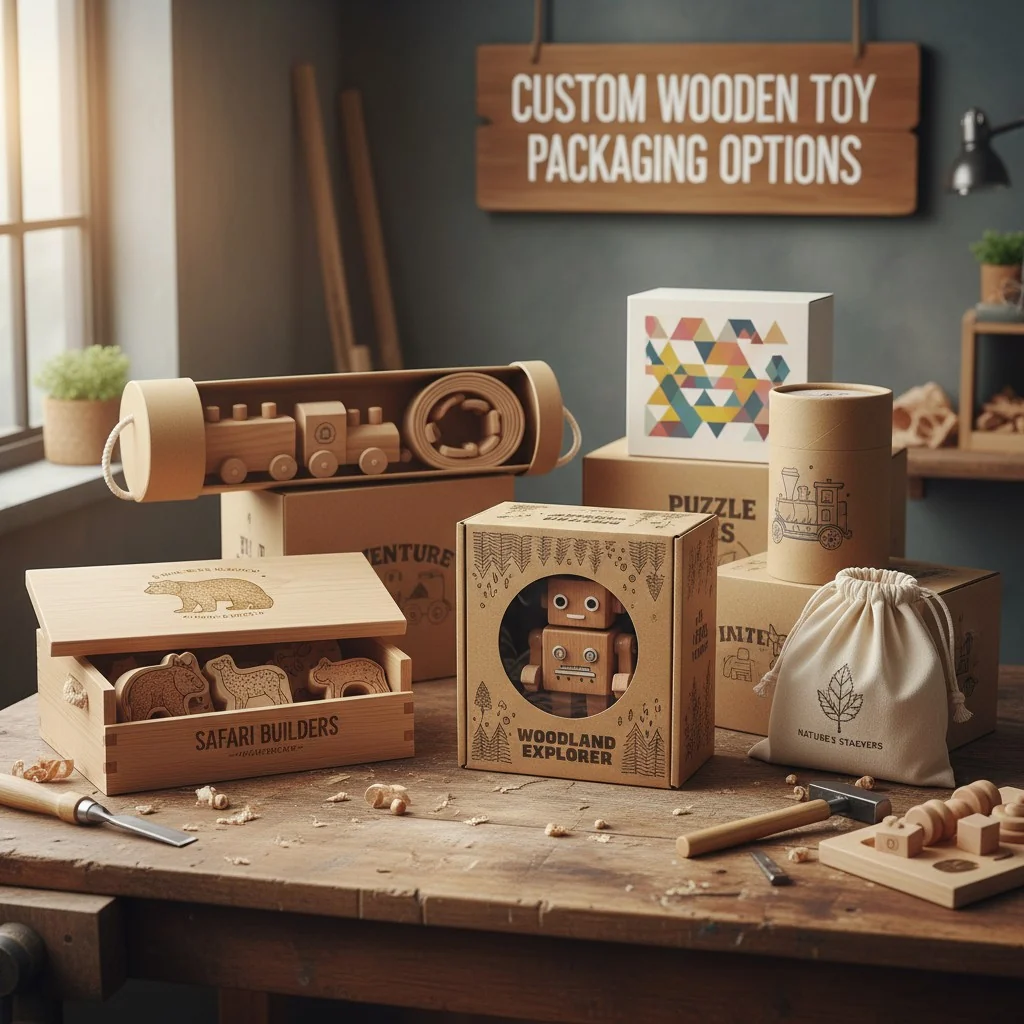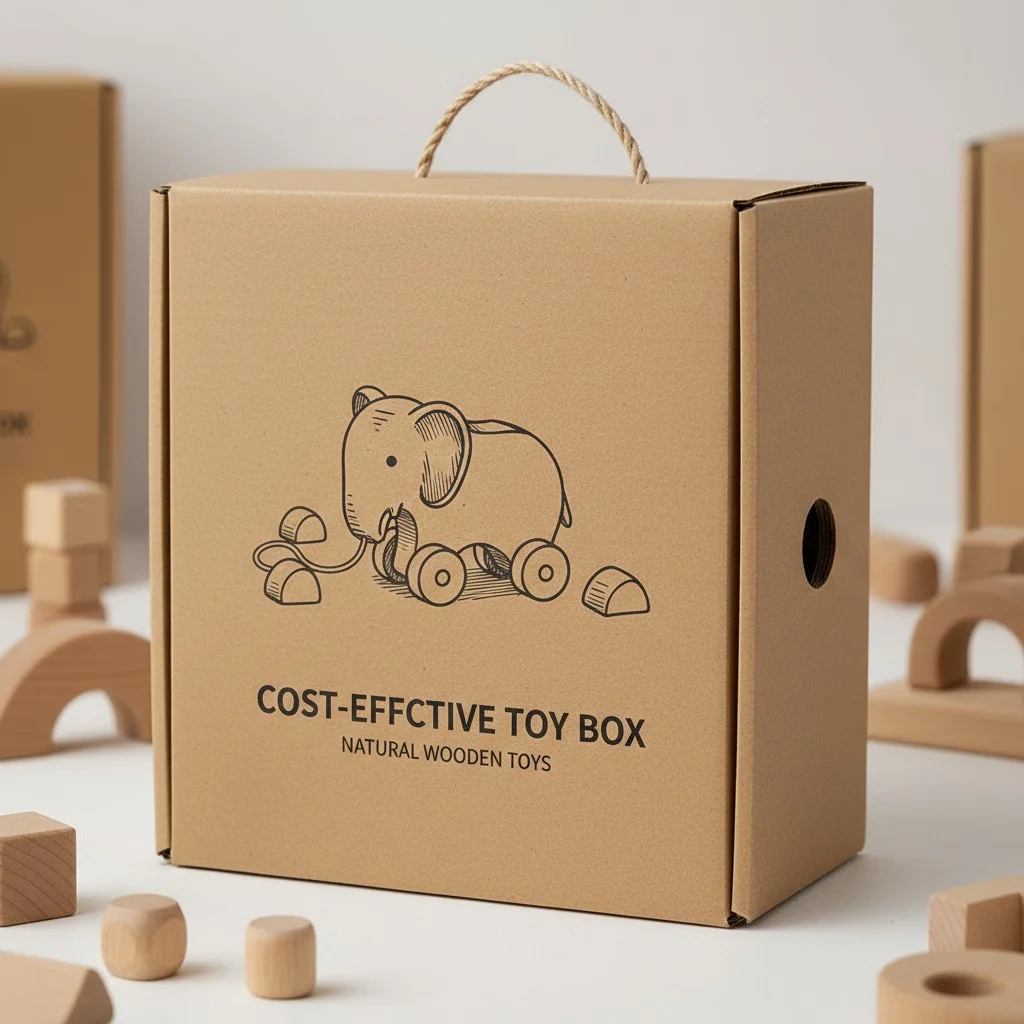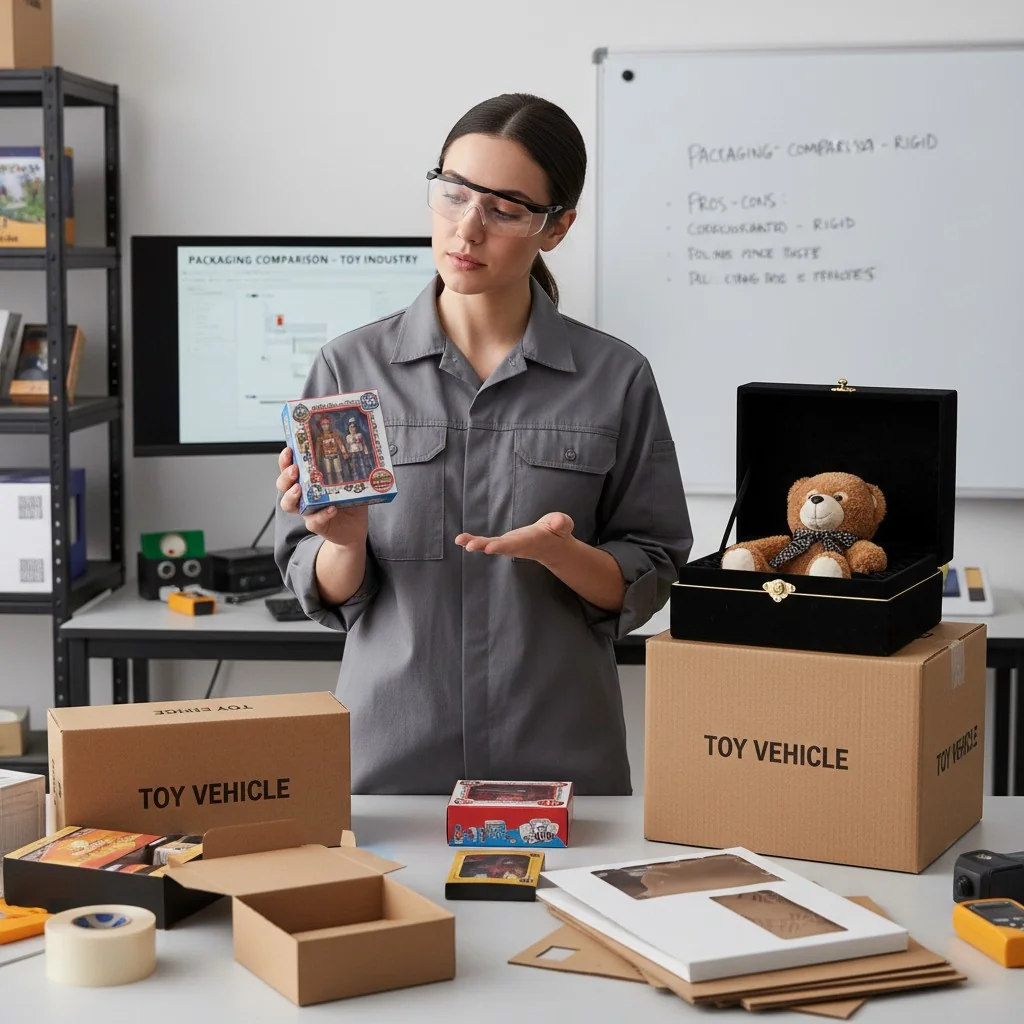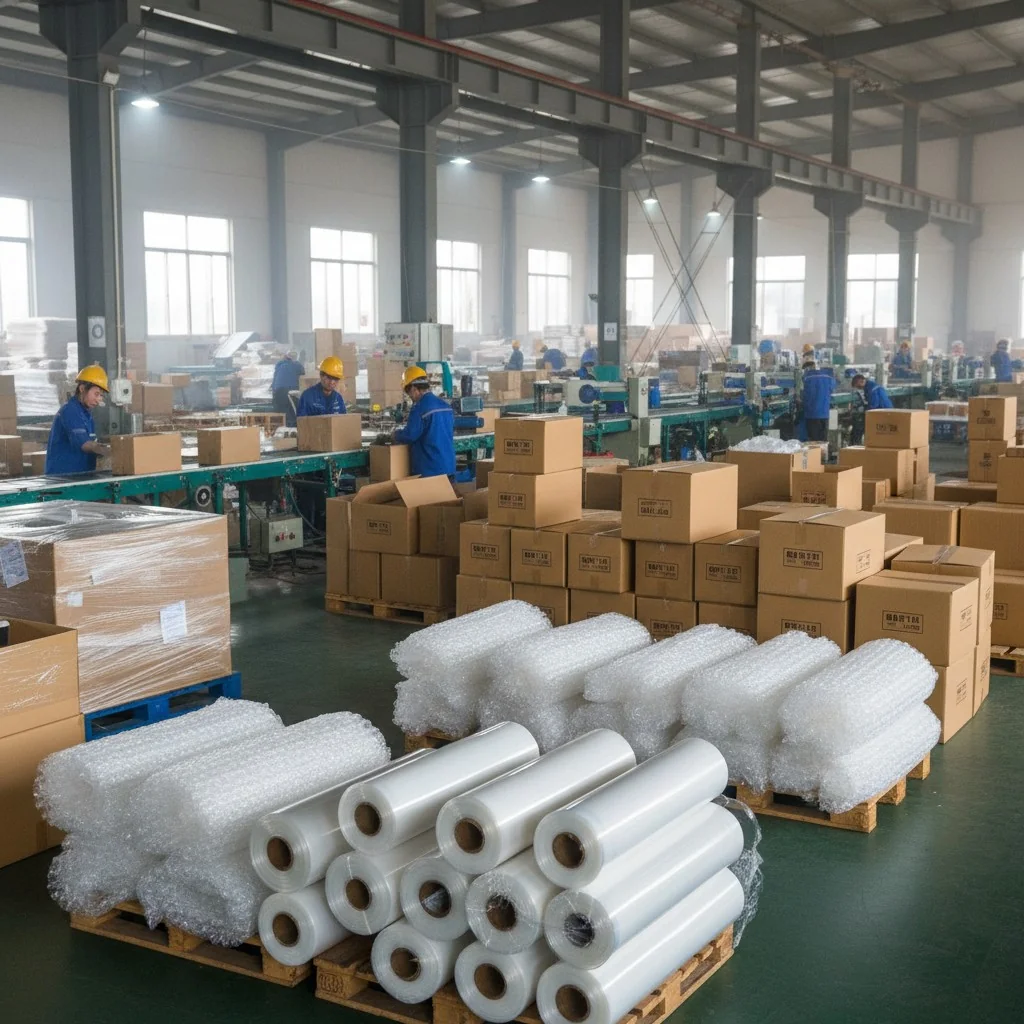
High packaging costs can shrink your profits. You want beautiful packaging for your custom wooden toys[^1], but the expense feels overwhelming. I'll show you how to save money without compromising.
When customizing wooden toys, packaging options[^2] range from simple OPP bags to custom-printed color boxes and sturdy mailers. The key to saving costs is choosing the most efficient option, like a well-designed folding carton, that protects the toy without adding unnecessary weight or material expense.

Choosing the right packaging seems simple on the surface. But as someone who has navigated this process with countless clients, I can tell you the details are where you win or lose. The difference between a profitable product line and a costly mistake often comes down to the box it ships in. It's about more than just looks; it's about protection, shipping weight, and assembly time. Let's dive into how you can make the smartest choice for your project and your budget.
All eco-friendly packaging options are significantly more expensive than standard materials.False
This is a common misconception. While some specialty bio-plastics can be pricey, options like recycled cardboard or kraft paper are often cost-competitive with virgin materials and can even be cheaper in some cases.
The weight and dimensions of your packaging directly impact your shipping costs.True
Carriers use dimensional weight (DIM) and actual weight to calculate shipping fees. Lighter, more compact packaging can lead to substantial savings, especially for international freight.
How can you choose the right packing box to save costs?
Are you overwhelmed by the different types of boxes? Corrugated, rigid, folding carton[^3]... it's a lot to take in. Choosing the wrong one means you either overpay or risk damage.
To save costs, select the simplest box type that meets your needs. For most retail wooden toys, a folding paperboard carton is the most cost-effective choice. It offers good protection, excellent branding space, and keeps material and shipping costs[^4] low compared to heavier rigid or corrugated boxes.

I've seen many designers default to the fanciest, thickest box, thinking it means "premium." But that's not always the best strategy. Your goal is to find the sweet spot between protection, presentation, and price. I once worked with a client who was using expensive, heavy rigid boxes for a simple set of wooden blocks. They looked great, but the packaging cost was almost as much as the toy itself, and shipping was a nightmare. We redesigned it into a smart, single-wall folding carton with a custom insert. The cost per unit dropped by 60%, and they could fit twice as many units on a pallet. Let's break down the common options so you don't make the same mistake.
Comparing Common Box Types
| Box Type | Best For | Cost | Protection Level |
|---|---|---|---|
| Folding Carton | Retail shelves, lightweight toys | Low | Moderate |
| Corrugated Box | E-commerce, heavier toys, shipping | Medium | High |
| Rigid Box | Luxury gifts, high-end sets | High | Very High |
For most product designers like you, Jacky, the folding carton is your workhorse. It's versatile, easy to print on, and ships flat to save space and money. Only upgrade to corrugated if your toy is heavy or will be shipped directly to the consumer without an outer box.
A thicker box always provides better protection for the product inside.False
Protection is more about the box's structure and material grade than just its thickness. For corrugated boxes, the flute type (e.g., B-flute vs. E-flute) and internal supports often matter more than raw thickness.
Custom die-cut inserts can increase packaging costs but significantly reduce product damage rates.True
While adding an upfront cost, a well-designed insert holds the toy securely in place. This prevents movement and breakage during transit, which lowers costs associated with returns and damaged goods.
What are the most common packaging options from a China supplier like Woddlon Toy?
Sourcing from China but not sure what packaging options are standard? You might be missing out on cost-saving methods or getting quoted for things you don't really need.
Chinese suppliers[^5] most commonly offer OPP bags, bubble wrap, plain white or kraft boxes, and full-color printed folding cartons. OPP bags are the cheapest for bulk protection, while color boxes are the standard for retail-ready products. Always specify your exact requirements to get an accurate quote.

When I first started my trading company, I learned a valuable lesson: never assume. Don't assume your supplier knows what "standard packaging" means to you. I had a client who just said "box the toys." The factory, trying to be cost-effective, put each toy in a thin, plain white box. My client was expecting a full-color retail box. It created a huge delay and extra cost to get them all repackaged. From that day on, I created a clear spec sheet for every project. You need to be explicit about what you want. Most suppliers, including specialists like Woddlon Toy, are very flexible and can provide exactly what you need if you give them clear instructions.
Standard Packaging Tiers from Chinese Suppliers
Here’s a breakdown of what you can typically expect, from cheapest to most expensive:
- Tier 1: Bulk Pack / OPP Bag: This is the most basic option. Each toy is placed in a simple, clear plastic (OPP) bag to prevent scratches. They are then packed in a large master carton. This is great for items sold in sets or if you plan to do the final packaging yourself.
- Tier 2: White Box / Kraft Box: A simple, unprinted cardboard box. It offers good protection during shipping. You can easily brand it with a custom sticker for a low-cost, minimalist look.
- Tier 3: Color Box (Folding Carton): This is the most common choice for retail. It's a paperboard box with full-color CMYK printing. The cost depends on the size, paper thickness, and any special finishes.
- Tier 4: Mailer Box (Corrugated): A sturdier corrugated box designed to be shipped directly to a customer. It's perfect for e-commerce brands. It can be plain kraft or fully printed.
The price a Chinese supplier quotes for packaging is always final and non-negotiable.False
Packaging prices are often negotiable, especially with larger order quantities. You can also reduce costs by simplifying the design, such as reducing the number of print colors or removing a special finish.
Providing a detailed packaging specification file, including a dieline and artwork, to your supplier is essential.True
Clear, professional files prevent misunderstandings about dimensions, materials, colors, and layout. This ensures you get exactly what you expect and avoids costly errors and delays in production.
Beyond the box, what other packaging details affect your final cost?
You've picked your box, but then the final invoice arrives with surprise charges. Hidden costs from printing, finishes, and assembly can quickly inflate your budget if you're not careful.
Beyond the basic box, your final cost is heavily influenced by printing methods[^6] (CMYK vs. Pantone), surface finishes like lamination, the need for custom inserts, and any manual assembly required. Each of these elements adds to the per-unit price.

I remember a project for a client who designed a beautiful box with a special die-cut window, a matte lamination, and a spot UV logo. It looked incredible. The problem was, each of those features added cost. The spot UV alone added a few cents per box, which doesn't sound like much. But when you're making 10,000 units, it adds up to a significant amount. We had to go back and decide which feature was most important for the brand and which could be removed to meet the target cost. Understanding these small details before you commit to a design is critical for managing your budget effectively.
Key Cost Factors in Custom Packaging
Think of these as levers you can pull to adjust your final cost.
| Factor | Description | Cost Impact |
|---|---|---|
| Printing | CMYK is standard for photos. Pantone (PMS) is for specific brand colors. | Pantone colors require separate ink mixes and press setups, making them more expensive. |
| Finishes | Lamination (matte/gloss) adds durability. Spot UV adds a shiny texture to specific areas. | Each finish is an additional machine process, adding cost and time. Matte lamination is often slightly more expensive than gloss. |
| Inserts | Cardboard, molded paper pulp, or foam inserts that hold the product. | Custom inserts require a unique cutting die or mold, which is an upfront tooling cost. Complex inserts also increase assembly time. |
| Assembly | Whether the box is shipped flat or fully assembled with the toy inside. | Pre-assembling boxes at the factory requires manual labor, which adds to the cost. Shipping flat is cheaper but requires assembly on your end. |
Always ask your supplier for a price breakdown. This will show you exactly where the money is going and help you decide if that extra finish is really worth it.
Shipping boxes flat-packed is always the cheapest overall option.False
While flat-packing saves on shipping volume from the factory, if the box is complex to assemble, the labor cost at your warehouse or fulfillment center might be higher than the shipping savings.
Requesting a physical packaging sample before mass production is a critical step.True
A physical sample allows you to test the toy's fit, check the material quality, and approve print colors in person. This simple step can prevent a disastrously expensive mistake on the full production run.
Conclusion
Choosing the right packaging is a strategic balance. Focus on simple, effective solutions like folding cartons to protect your wooden toys, your brand image, and most importantly, your budget.
Reference
[^1]: Explore effective strategies for packaging custom wooden toys to enhance presentation and protect your products.
[^2]: Discover various packaging options available for wooden toys to find the best fit for your needs.
[^3]: Learn why folding cartons are a cost-effective and versatile packaging solution for many products.
[^4]: Understand how packaging choices can significantly impact your shipping expenses and overall budget.
[^5]: Get insights into the standard packaging options available from Chinese suppliers to optimize your sourcing.
[^6]: Discover the various printing methods available for packaging and how they affect cost and quality.
